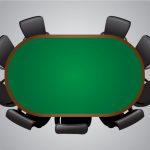In Part 1 of this series, we looked at how to calculate your expected value (EV) for pushing all in from the small blind against the big blind. In Part 2, we’ll take a look at what to do with very short stacks. There are a few factors that compliment the EV calculation when pushing with a short stack, including maintaining fold equity and the size of the big blind’s stack.
Short Stack Pushes
As seen in our EV example in Part 1, some of the equity in our calculation comes from “fold equity.” This is the the percentage of time where we push, and the big blind folds, allowing us to pick up the blinds and antes with no showdown. One unfortunate aspect of having an extremely short stack in the small blind is that our fold equity can actually completely disappear. If the big blind only has to call for a small amount of chips relative to the amount in the pot preflop, sometimes they can correctly make the call with any two cards. Let’s take a look at somewhat of an extreme example to illustrate this point.
Blinds are 250/500 with antes of 50 at a full 9-player table. After posting the ante and the small blind, we only have 750 chips left, and the big blind has a very comfortable stack. There are 1,200 chips in the pot preflop, and when the action folds around to us in the small blind, we push all in. Now there are 1,950 chips in the pot, and the big blind only has to call 500 more for a chance at winning the pot. His pot odds are a little less than 4 to 1, meaning he only has to win against our hand 20% of the time to make his call profitable. Even if he puts on any reasonable range of hands and thinks we might not be pushing with any two cards ourselves, the big blind will still have better than 20% equity against our hand, no matter what he has. He can profitably call with any two cards in this situation.
However, even though we know he should be calling with any two cards, we should still push all in no matter what we have. Even a hand as weak as 32o still has 32.3% equity against a random hand. Adjusting the EV calculation to eliminate times where the big blind folds, we stand to win 1,700 chips if our 32o holds up, and lose 700 if it doesn’t.
0.323 * 1700 = 549.1 (big blind calls, we win)
0.677 * -700 = -473.9 (big blind calls, we lose)
549.1 – 473.9 = 75.2 (total EV for push)
So, since there is so much in the pot preflop relative to our stack, it is always going to be +EV to push any two cards from the small blind when we are this short. Note that since the big blind is never folding, the chance that we will bust out of the tournament is the same as the big blind’s equity in the hand, 67.7% in this case.
Since fold equity can make up a good part of our overall equity when we push all in, we generally would prefer to not get into this sort of spot in the first place. If we have no fold equity, we have to rely strictly on the strength of our hand vs the big blind’s hand, and our risk of busting out of the tournament is higher since we’re always getting called. So how many chips do we need to have to still have fold equity? Well, a lot of that depends on the big blind and how much he knows about the math behind push/fold situations. However, a general rule of thumb is that you still have fold equity if your stack is more than five times the big blind. Note that this means your stack needs to be five times the amount that the big blind is posting, not five times his stack! If we look at the example above, we would need to have about 2,500 chips left after posting the small blind and ante. Then, if we push, the big blind needs to call 2,250 to win 3,700, giving him odds of about 1.6 to 1. This means the big blind has to win about 38% of the time against us in order to break even. In this case, even if the big blind thinks we are pushing any two cards, he can not profitably call with his weaker hands. For example, if he has 32o, he only has an equity of only 32.3% against a random hand. If he thinks we are not pushing all-in with our weakest hands, he has to tighten up his calling range even further to have his calls be profitable.
So, if we do find ourselves in a situation where we only have five times the big blind (5xBB), then we have a motivation to push all-in. We want to be able to take down the blinds and antes (or possibly double up if called), so that we can keep our stack above the 5xBB mark and retain our fold equity. But what hands can we push with when we have 5xBB? Let’s take a look.
Sticking with the scenario we’ve been using, blinds are 250/500 with antes of 50. We have 2,500 chips after posting, and the action is folded to us. Let’s assume that the big blind is going to play somewhat tight, but is going to call us about 25% of the time. We’ll give him a range that looks something like this: 44+,A5o+,A2s+,K9o+,K7s+,QTo+,Q9s+,JTs. So, knowing that he’s calling 25% of the time, he’s folding 75% of the time, and we pick up the 1,200 chips in the pot.
0.75 * 1200 = 900 (big blind folds)
Let’s first give us a medium strength hand like 98s and see how we fare. Our equity vs the big blind’s range is 38.6%. If we are called and win, we pick up 3,450 chips (1,200 in the pot preflop plus 2,250 from the big blind’s call).
0.25 * 0.386 * 3450 = 332.93 (big blind calls, we win)
Of the times we’re called, we lose 61.4% of the time, and lose our entire stack
0.25 * 0.614 * -2500 = -383.75 (big blind calls, we lose)
Adding these together gives our EV:
900 + 332.93 -383.75 = 849.18 (total EV for push)
Our chance of busting out is the percentage of times the big blind calls, multiplied by his equity:
0.25 * 0.614 = 15.4% (chance of busting)
So, we can see that pushing 98s is +EV in this spot. Looking a little more closely at the numbers, we can see that the majority of our EV comes from our fold equity, since the big blind is folding 75% of the time. If that’s the case, then our equity in the hand on the times that we are called shouldn’t really matter too much. Let’s run the example again with a very weak hand. If we hold 32o, our equity vs the big blind’s range only drops to 29.1%. We still win almost 3 out of 10 times that we’re called. If we run the numbers again, this is what we get:
0.75 * 1200 = 900 (big blind folds)
0.25 * 0.291 * 3450 = 250.99 (big blind calls, we win)
0.25 * 0.709 * -2500 = -443.13 (big blind calls, we lose)
900 + 250.99 -443.13 = 707.87 (total EV for push)
0.25 * 0.709 = 17.7% (chance of busting)
So, as we can see, if the big blind is folding this often, we can push all-in with any two cards and still expect that play to be +EV. Also notice that our chance of busting with our 32o is only 17.7%, compared with the 67.7% of the time when the big blind is calling with any two. Although this risk is not insignificant, we are still +EV and the amount of chips we stand to gain just by picking up the blinds and antes makes a push the right play, since we have a good chance to maintain our fold equity for future pushes.
But what if the big blind is calling more often than 25% of the time? Let’s open up his range and see what happens if he calls our 32o with 50% of his hands. Now the big blind is calling with any pair, any Ace or King, any two broadway cards, and a wide variety of suited cards. Our equity against this range is 30.5%, slightly better than when he was calling us with only 25% of his hands. Running the equity calculations again:
0.50 * 1200 = 600 (big blind folds)
0.50 * 0.305 * 3450 = 526.13 (big blind calls, we win)
0.50 * 0.695 * -2500 = -868.75 (big blind calls, we lose)
600 + 526.13 – 868.75 = 257.38 (total EV for push)
0.50 * 0.695 = 34.75% (chance of busting)
Note that we are still +EV here, even with our weakest hands. By playing around with the numbers, the break even point for pushing 32o with our stack is when the big blind is calling with about 65% of his hands. With that in mind, I generally will push all but my weakest hands when I am in the small blind with a stack of about 5xBB.
While estimating the big blind’s calling range can be difficult, there are a couple other factors to consider. One is how much damage you can do to the big blind’s stack if he calls and loses. If the big blind has a huge stack, and calling you won’t really hurt his standing in the tournament, often he will call with a wider range. If the big blind has a stack of only about 10xBB, he may be less inclined to call you with his weaker hands, tightening his range and making your push more +EV. Your image at the table can also affect the big blind’s calling range. If you’ve been playing tight, and showing down solid hands, your push can be interpreted as stronger than if you’ve been pushing every other hand and showing down weak hands.
In our next segment, we’ll take a look at pushing with larger stacks, and introduce the concept of the “unexploitable push.” Stay tuned for Part 3.
Be sure to check out the other parts of this article, as it is a multi-part series!
Submit your review | |








